Is Islamic feminism in total contrary to Western feminism? What are Islamic feminists fighting for and can one use the term “feminism” relating to Islam? How do Iranian women act with their rights in a country which is a role model for women’s oppression in the Western world? In my work I want to answer these and other questions.
In the first part of the following work I give a general overview of Islamic feminism. I will define the term and distinct it from what is known as “Western feminism”. I introduce “three ideal types” of Islamic feminists and describe the Islamic feminist discourse and activism according to the Islamic jurisprudence and tradition.
After that I focus on the women and their feminism in Iran. Feminism has a long history in Iran and is in total contrary to Western feminism. But the aims of the Islamic feminists changed from during the Islamic Revolution in 1979. Journalism and women’s magazines are a very important organ of the feminists in Iran. Both the “religious” and “secular” spheres use it to discuss women’s issues and criticise actual political decisions and social grievance. I will picture the most important magazines and the most discussed topics.
In the last part I introduce one of the latest campaigns of feminists in the Arab world. “The Uprising of Women in the Arab World” is a movement which uses Social Media such as Facebook and Twitter to inform people and criticise the on-going oppression of women after the Arab Spring and the increasing sexual harassment in Arab countries.
Table of Contents
- Introduction
- Islamic Feminism - A General Overview
- What's in a name?
- Feminism
- Islamic Feminism
- Three ideal types...
- Emerge of Islamic feminism
- Islamic Feminist discourse and activism
- Tafsir....
- Hadiths
- Fiqh......
- Religious professions......
- The mosque..
- Feminist Hermeneutics
- Hijab and Modernity.
- Islamic Feminism - An Iranian Case Study.
- Women in Post-Revolutionary Iran.......
- Necropolitics and the Islamist Call to Activism
- Shia Scholars and Intellectuals on Islamic Feminism
- On Women's Employment.
- Latest Events
- Journalism in post-revolutionary Iran.
- Women's Magazines - An Overview.
- Situation of Female Journalists
- Socio-political Questions in Iranian Women's Magazines (not all)...
- Feminism after the Arab Spring: The uprising of women in the Arab World. Feminist activities in Social Media
Objectives and Key Themes
This paper examines Islamic feminism, specifically its activities and its role in the Islamic Republic of Iran. The author aims to answer questions regarding the relationship between Islamic and Western feminism, the specific objectives of Islamic feminists, and the role of women's rights in a country often viewed as oppressive towards women. The work will also explore the utilization of journalism and women's magazines as tools for feminist discourse and activism in Iran.- The definition and distinction between Islamic feminism and Western feminism
- The historical emergence and development of Islamic feminism
- The role of the Islamic feminist discourse and activism within Islamic jurisprudence and tradition
- The situation of women in Iran and the impact of the Islamic Revolution on feminist movements
- The use of journalism and women's magazines as platforms for discussing women's issues and criticizing political and social grievances in Iran
Chapter Summaries
The first section of this work introduces the concept of Islamic feminism, exploring its various facets and defining it in comparison to "Western feminism." The author also presents a concept for classifying different types of feminists and analyzes the Islamic feminist discourse and activism within the context of Islamic jurisprudence and tradition. The second section focuses on the experiences of women and feminism in Iran, tracing its historical development and highlighting the distinct approach of Iranian feminism from its Western counterpart. The author emphasizes the significant role of journalism and women's magazines as platforms for feminist discourse and activism in Iran, exploring both religious and secular perspectives on women's issues and critique of political and social grievances. The third section delves into the "Uprising of Women in the Arab World," a movement utilizing social media platforms such as Facebook and Twitter to raise awareness and address the ongoing oppression and increasing sexual harassment of women in Arab countries following the Arab Spring.Keywords
This work explores the key concepts of Islamic feminism, Western feminism, feminist discourse and activism, Islamic jurisprudence, women's rights, the situation of women in Iran, Iranian women's magazines, journalism, and social media as tools for feminist movements in the Arab world.- Quote paper
- Ann Cathrin Riedel (Author), 2013, Islamic Feminism. An overview of Islamic feminism activities with a focus on the Islamic feminism in the Islamic Republic of Iran, Munich, GRIN Verlag, https://www.grin.com/document/211932



